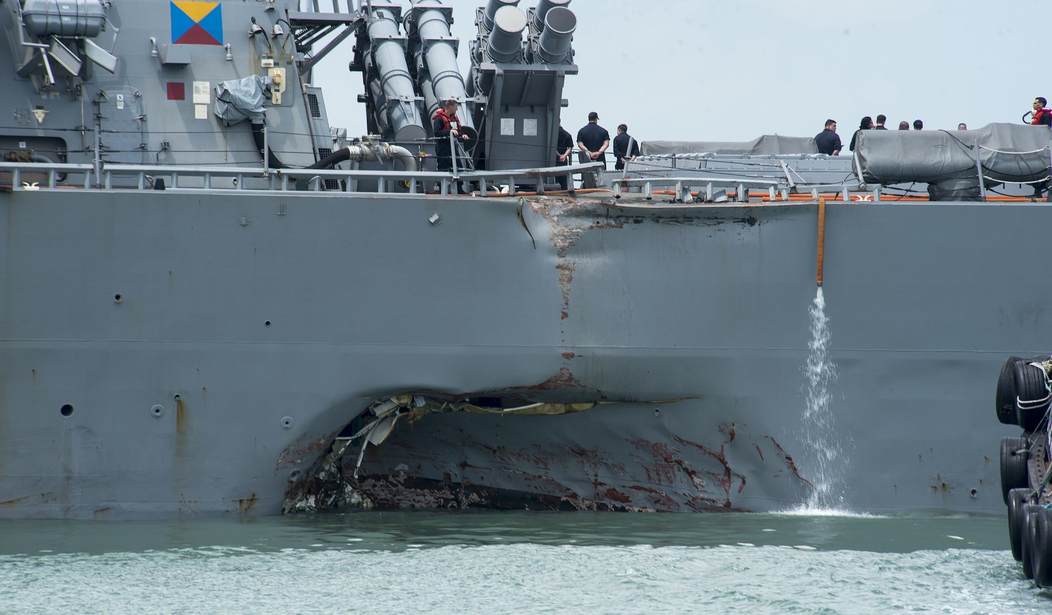There’s a scathing report from ProPublica detailing how Navy cost-cutting helped end the lives of ten sailors on the USS John S. McCain in a fatal 2017 collision with a Liberian-flagged tanker. A Navy official told CNN shortly after the deadly incident that “it was unclear why the crew couldn’t use the ship’s backup steering systems to maintain control.” But it might just be the result of the Navy’s money-saving decision to rely on touchscreen controls to pilot the ship, instead of traditional methods.
ProPublica detailed the control system, which “featured slick black touch screens,” and “knit together information from radars and digital maps.” Which is all well and good. “It would save money by requiring fewer sailors to safely steer the ship,” according to ProPublica and Navy sources. But training was apparently lacking, as 23-year-old McCain sailor Dakota Bordeaux said, “There was actually a lot of functions on there that I had no clue what on earth they did.”
The same was true for Cmdr. Alfredo Sanchez, captain of the McCain. From ProPublica:
A 19-year Navy veteran, Sanchez had watched as technicians replaced the ship’s traditional steering controls a year earlier with the new navigation system. Almost from the start, it caused him headaches. The system constantly indicated problems with steering. They were mostly false alarms, quickly fixed, but by March 2017, Sanchez’s engineers were calling the system “unstable,” with “multiple and cascading failures regularly.”
Sanchez grew to distrust the navigation system, especially for use in delicate operations. He often ordered it to run in backup manual mode, which eliminated some of the automated functions but also created new risks.
In August 2017, Sanchez and his crew steered the ship toward a naval base in Singapore, where technicians were waiting. The navigation system had indicated more than 60 “major steering faults” during the month.
Sanchez had planned to have the system’s programmers “give the system a full check, a full clean bill of health,” but the collision occurred, killing ten of his sailors, before that could happen. What did happen was just ugly. On August 21, 2017, the McCain was sailing the crowded shipping lanes 20 miles from Singapore. Sanchez was on the bridge, monitoring the situation, with Bordeaux in charge of steering the ship (via touchscreen controls) while another sailor manned the virtual throttle. But something went wrong, whether with the under-trained sailors, the touchscreen controls, or the system itself. Whatever the case, the McCain did not respond correctly to course adjustments.
The Navy is in a tough spot. Recruiting is rarely easy, and it’s harder still with a fleet consisting of too few ships enduring too long deployments. Complicating matters, believe it or not, is the hot economy. The unemployment rate is so low, and wages so high, that it’s getting more and more difficult to tempt people to join the military.
That’s why the Navy spent so much R&D on its new Ford-class nuclear-powered aircraft carriers. Much of that spending was on automation systems to reduce crew requirements. The crew of the Ford (still undergoing trials) is expected to top out at around 2,600 officers and men, down from 3,532 on the existing Nimitz-class CVNs. That’s a big savings in wages and operating expenses, but at what cost?
It might also be that some jobs just don’t lend themselves to touchscreen controls. A real-world example of that, albeit with much lower stakes, was my decision last year to ditch my laptop in favor of going all-in on an iPad Pro. The move went just fine, except for one thing: WordPress, the software we use for all our blogging here at PJMedia and Instapundit, doesn’t have touch-friendly controls. For all the things I do on mobile, the iPad’s touchscreen was just as good and sometimes better than a traditional laptop touchpad. But the WordPress blogging experience was so awful that a couple months ago I broke down and bought another laptop.
I’m probably not going too far out on a limb here, conjecturing that navigating a 100,000 horsepower, 505-foot long guided-missile destroyer displacing almost 9,000 tons fully loaded, is another one of those tasks not exactly conducive to touchscreen controls.
In the case of the McCain, confusion over how one automation system was supposed to work, or even whether it was working correctly, contributed to the deaths of nearly a dozen sailors.
Less staffing means fewer hands onboard for damage control. The U.S. Navy historically has excelled at keeping afloat damaged ships that other navies — particularly the Japanese in WWII — would have lost. (For a great history of WWII including fascinating details of the importance of crew-wide damage-control training, I can’t recommend Shattered Sword: The Untold Story of the Battle of Midway too highly.) What might happen when the shooting starts, when an extremely high-tech vessel like the USS Ford takes on battle damage, but has hundreds fewer men to fight and contain it?
These are serious issues, but given very real constraints on funding and manpower, maybe ones with no good solutions. Perhaps the best thing we can do is continue building up to a 355-ship fleet, allowing for shorter deployments and — more importantly — a much greater emphasis on training. If we can do that, then perhaps the men of McCain won’t have given their lives in vain.










